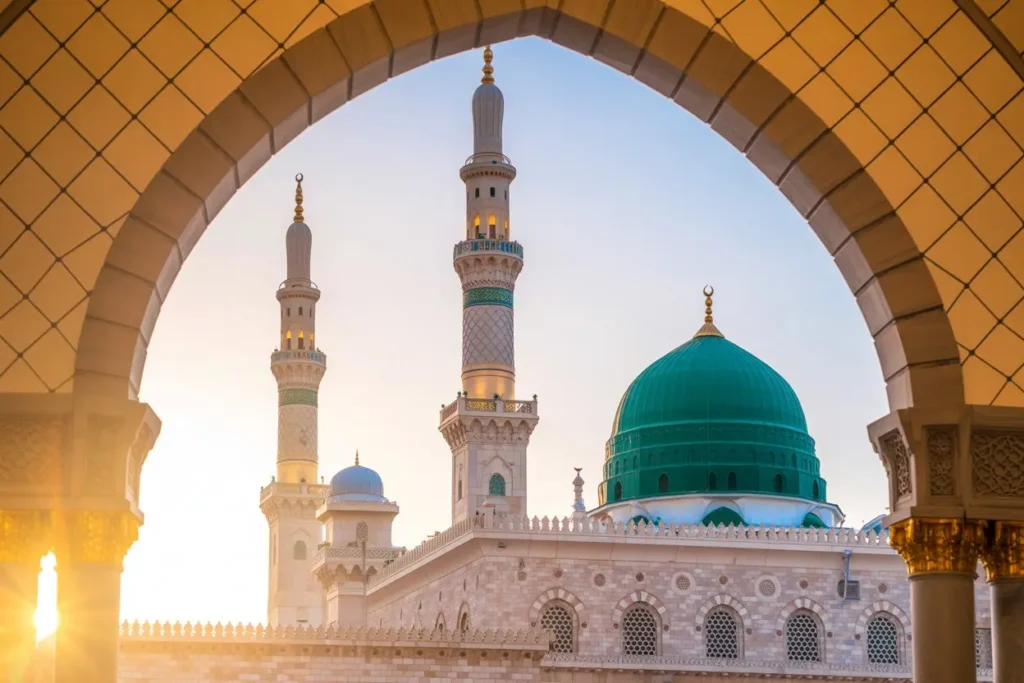Introduction

If you’re planning a spiritual journey to Madinah, you’re in for a deeply moving experience. This city isn’t just historical; it’s the heart of Islam after Makkah. Visiting the ziyarat places in Madinah connects us with the life of the Prophet ﷺ, his companions, and the soul of our faith. Each step echoes history, each site tells a story, and every corner carries a scent of sacredness. In this guide, we’ll walk together through important mosques in Madina, hidden gems, and powerful moments from Islamic history. Whether you’re visiting for the first time or the fifth, there’s always more to discover in the blessed city of the Prophet ﷺ.
What is Ziyarat? The Meaning Behind the Journey

Ziyarat means “visit,” but in the Islamic context, it refers to the act of visiting holy places, particularly those associated with the Prophet Muhammad ﷺ, his family, and his companions. It’s not just sightseeing. Ziyarat is a spiritual act filled with love, connection, and dua.
When we do ziyarat in Madinah, we aren’t just walking into mosques and cemeteries—we’re stepping into chapters of Islamic history. It’s a way to reflect, increase love for the Prophet ﷺ, and boost our Imaan. For many pilgrims from Pakistan and beyond, this journey becomes one of the most emotional parts of Umrah.
Why Visit Ziyarat Places in Madinah?
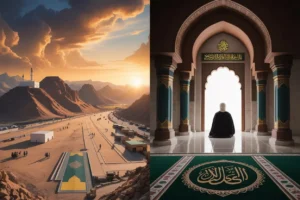
(Spiritual & Historical Value)
Madinah is the city of light. The Prophet ﷺ lived here for 10 years. It’s where Islam blossomed into a powerful and peaceful civilization. By visiting historical places in Medina, we don’t just learn history—we feel it. You can stand on the battlefield of Uhud, pray where the Qiblah changed, and reflect in the garden of Rawdah.
There’s also great reward. The Prophet ﷺ said:
“Whoever visits me after my death, it is as if he visited me in my lifetime.” (Bayhaqi)
Visiting these blessed places reminds us of sacrifice, strengthens our hearts, and brings our duas closer to acceptance.
Rules & Etiquettes of Performing Ziyarat in Madinah
Ziyarat must be done with the right mindset. Here’s how to do it properly:
- Intention (Niyyah): Make the intention for spiritual benefit, not just tourism.
- Dress Modestly: What to wear for Ziyarat? Men should wear simple white clothes. Women should wear loose, full-length garments with head coverings.
- Respect & Quietness: Avoid loud talking, laughter, or taking selfies inside sacred places.
- Cleanliness: Be in a state of wudu wherever possible.
- Follow Timing Guidelines: Especially for sisters, follow ziyarat timing for women in Madinah, usually in the early mornings or midday depending on local rules.
These etiquettes help us maintain the sanctity of the experience and receive its spiritual rewards.
Top 10 Must-Visit Ziyarat Places in Madinah.
Al-Masjid an-Nabawi (The Prophet’s Mosque)
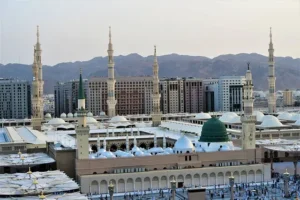
This is the heart of Madinah and the second holiest site in Islam. Masjid Nabawi Rawdah is located inside, famously called Riyadh ul-Jannah, “a garden from paradise.”
The Prophet ﷺ said:
“What is between my house and my pulpit is a garden from the gardens of Paradise.”
(Sahih Bukhari)
Spending time here, especially in Rawdah, brings unmatched peace. It’s also the place where the Prophet ﷺ is buried, alongside Abu Bakr and Umar رضي الله عنهما.
Read more about Masjid Nabawi here.
Jannat al-Baqi
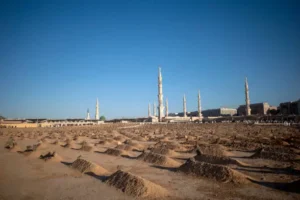
This ancient cemetery is home to the famous sahaba buried in Jannat al Baqi, including:
- Hazrat Uthman ibn Affan رضي الله عنه
- Hazrat Imam Hasan ibn Ali رضي الله عنه
- Hazrat Aisha رضي الله عنها
- Hazrat Fatima رضي الله عنها (according to many scholars)
The Prophet ﷺ often visited Baqi and made dua:
“Peace be upon you, O people of the dwellings! From the believers and the Muslims. Indeed, we are, Allah willing, to join you.”
(Sahih Muslim)
Visiting this graveyard reminds us of death, humbles our hearts, and teaches us gratitude.
Masjid Quba
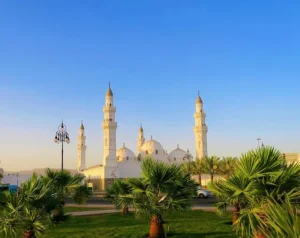
Masjid Quba is the first mosque built in Islam. The Prophet ﷺ helped construct it with his own hands. He said:
“Whoever makes ablution in his house, then comes to Masjid Quba and prays two rak’ahs, he will have a reward like that of Umrah.”
(Sunan Ibn Majah)
This shows the importance of Masjid Quba in Islam and its unique reward. It is a peaceful, clean masjid and a must-visit for every pilgrim.
Masjid Ghamama

Masjid Ghamama is just a few steps from Masjid Nabawi. This sacred mosque is tied to a moment of hope and mercy. It’s said that the Prophet Muhammad ﷺ once led the Salat al-Istisqa (prayer for rain) here during a time of drought in Madinah. As he completed the prayer, clouds gathered and rain fell—hence the name “Ghamama,” which means “cloud” in Arabic.
🌧️ Hadith:
صَلَّى رَسُولُ اللَّهِ ﷺ صَلَاةَ الاسْتِسْقَاءِ بِالْمُصَلَّى، فَدَعَا وَاسْتَغْفَرَ، فَأَنْشَأَ اللَّهُ سَحَابًا وَأَمْطَرَ
“The Messenger of Allah ﷺ performed the prayer for rain (Salat al-Istisqa) and supplicate to Allah. Allah created clouds and it rained.”
(Sahih Muslim)
This mosque is a reminder of how faith and du‘a can bring about divine mercy. When visiting, many pilgrims sit quietly here and ask Allah for their own needs, just as the Prophet ﷺ did.
Masjid Jumuah
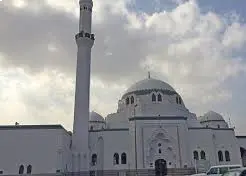
Masjid Jumuah marks a deeply spiritual event—the first Friday prayer led by the Prophet ﷺ in Madinah, shortly after his Hijrah (migration) from Makkah. This small mosque stands as a symbol of the beginning of Islamic community life in Madinah.
🕌 Hadith Event:
The Prophet ﷺ stopped in the area of Banu Salim ibn ‘Awf, and on Friday, he led Salat al-Jumuah with around 100 companions. It was a brief stop but held great importance.
📖 Scholars mention:
أَوَّلُ جُمُعَةٍ جُمِّعَتْ بَعْدَ هِجْرَةِ رَسُولِ اللَّهِ ﷺ كَانَتْ فِي مَسْجِدِ بَنِي سَالِمٍ
“The first Jumu‘ah after the migration of the Messenger of Allah ﷺ was held in the mosque of Banu Salim.”
(Ibn Sa’d, Tabaqat)
When you visit Masjid Jumuah, it’s like walking through the early pages of Islamic history, where unity, prayer, and brotherhood were just taking root. It’s a great place to reflect on your connection to the Ummah and the power of congregational worship.
Masjid Al-Ijabah
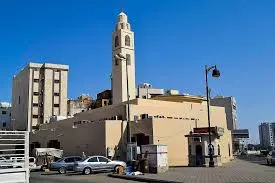
Masjid Al-Ijabah is a small but deeply spiritual mosque in Madinah where three special du‘as of the Prophet Muhammad ﷺ were accepted by Allah. The word “Ijabah” means acceptance, highlighting the significance of this site.
📍This mosque is located near Jannat al-Baqi and is known for its peaceful and quiet surroundings. Pilgrims visit this spot to reflect and make personal du‘as, following the example of the Prophet ﷺ.
🕋 Hadith:
سَأَلْتُ رَبِّي ثَلاَثًا، فَأَعْطَانِي اثْنَتَيْنِ، وَمَنَعَنِي وَاحِدَةً
“I asked my Lord for three things: He granted me two and withheld one…”
(Sahih Muslim)
The Prophet ﷺ prayed here asking for protection of his Ummah, and two of his requests were accepted. This hadith shows the power of sincere supplication. Visitors often come here to make du‘a with humility, believing this place holds blessings for those who seek it.
The Seven Mosques (Al-Masajid As-Sab’ah)
This group of interconnected small mosques is located near the site of the Battle of the Trench (Ghazwat al-Khandaq). Each mosque marks a specific place where the Prophet ﷺ or his companions took their positions during this important battle.
🗡️ The Khandaq battlefield Madinah was where the Muslims defended Madinah from a coalition of tribes using a trench—an idea inspired by Salman al-Farsi (RA).
💬 According to narrations, the Prophet ﷺ said:
اللَّهُمَّ لاَ عَيْشَ إِلاَّ عَيْشُ الآخِرَةِ، فَاغْفِرْ لِلأَنْصَارِ وَالْمُهَاجِرَةِ
“O Allah! There is no life worth living except the life of the Hereafter. So forgive the Ansar and the Muhajirun.”
(Sahih al-Bukhari)
🕌 The seven mosques include:
- Masjid Al-Fath
- Masjid Salman Al-Farsi
- Masjid Abu Bakr
- Masjid Umar
- Masjid Ali
- Masjid Fatimah
- Masjid Al-Khandaq
The Seven Mosques – History & Purpose
These small mosques were built at or near the location of tents and stations during the Battle of the Trench (Ghazwat al-Khandaq). Each mosque represents the spot where key figures among the Sahabah stood for worship and defense. They’re located close to each other, on the western side of Mount Sela. The reason they’re close together is because that area was the defensive frontline during the battle.
Now, let’s briefly look at each:
Masjid Al-Fath (مسجد الفتح)
- Built at the spot where the Prophet ﷺ made du‘a for victory during the Battle of the Trench.
- Named “Al-Fath” (Victory) as his supplication was accepted here.
- It is the largest among the seven mosques.
Masjid Salman Al-Farsi (مسجد سلمان الفارسي)
- Dedicated to Salman Al-Farsi (RA) who suggested digging the trench.
- Marks his contribution to the battle’s strategy.
- A symbol of wisdom and loyalty.
Masjid Abu Bakr (مسجد أبي بكر)
- Built where Abu Bakr (RA) stood guard and prayed during the battle.
- Shows his presence and leadership beside the Prophet ﷺ.
Masjid Umar (مسجد عمر بن الخطاب)
- Marks the position of Umar ibn Al-Khattab (RA) during the defense.
- A small structure, close to Masjid Abu Bakr.
Masjid Ali (مسجد علي)
- Represents the spot of Ali ibn Abi Talib (RA), who was one of the key warriors.
- Linked to his bravery and prayers during the battle.
Masjid Fatimah (مسجد فاطمة)
- Named after Fatimah (RA), the daughter of the Prophet ﷺ.
- A small mosque honoring her role and presence in the area.
Masjid Al-Khandaq (مسجد الخندق)
- Also known as the “Mosque of the Trench”.
- Represents the general site of the Battle of the Trench, where many companions took positions.
These mosques are close together because the battle lines were tight and unified, and every companion had a role to play in that limited area. Visiting all seven gives us a sense of their unity, strength, and devotion during one of Islam’s most difficult battles.
.

